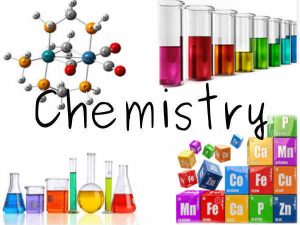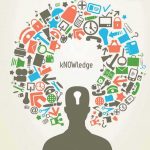Everything About Chemistry – A Basic Study – Learn Chemistry

What is CHEMISTRY
Chemistry is the branch of science which deals with study of matter and various changes it undergoes.
Classification of Matter
- Matter is defined as anything that occupies space and has mass.
- At a given temperature, an element is in one of the three states of matterSolid, Liquid or Vapour (Gas).
- Solids: Solids possess definite shape and volume.
- They have strongest intermolecular interactions.
- They are generally hard and rigid.
- Examples– Metals, bricks, wood, etc Liquids
- They possess definite volume but no definite shape.
- They have intemediate intermolecular forces between constituent particles.
- They can flow, so they are called fluids, e.g. water, milk, mercury, oil,etc. Gases
- Gases have neither a definite volume nor definite shape.
- They takes the volume and shape of the container. • They are highly compressible and have minimum intermolecular interactions..
- E.g.– air, oxygen, hydrogen, etc.
- Melting point of a substance is the temperature at which its solid form changes to a liquid.
- The melting point of water of a pressure of 1dtm or 760 mm Hg is 0 degree on the Celsius temperature scale and 32 degree on the Fahrenheit scale.
- Boiling point is the temperature at which the liquid form of a substance changes to a gas.
- The boiling point of water at a pressure of one atmosphere or 760 mm of mercury is 100 degree on the Celsius scale and 212 degree on the Fahrenheit scale.
- Crystalline materials however have a definite orderly arrangement of atoms, ions, or molecules.
- The orderly arrangement of particles or atoms in a crystal is called a crystal lattice. For instance, sand, salt, sugar, diamond and graphite are examples of crystalline materials.
- A physical change is a change in matter that involves no chemical reaction. In the case of a physical change a substance retains its chemical identity and molecular composition.
- The three types of physical changes are- melting, evaporation and freezing.
- A change in which the identify of the original substance is changed and new substances are formed is called a chemical change for example sourcing of milk, burning of paper, rusting of iron etc.
Learn Chemistry
ATOM
What is an Atom?
- An atom has a central nucleus which is very small compared to the rest of the atom and contains majority of the atomic mass.
- The nucleus carries a positive charge.
- The nucleus of an atom consists of protons and neutrons.
- Atoms consists of protons, neutrons, and electrons.
- Electrons revolves around the nucleus.
- Protons have a positive charge.
- Electrons have a negative charge.
- Neutrons have no charge.
- In a neutral atom total charge on proton is equal in magnitude to total charge on electrons.
- Since opposite charges attract protons and electrons attract each other.
ISOTOPES AND ISOBARS
Define ISOTOPES AND ISOBARS:
- Isotopes are atoms that have same atomic number but different mass numbers.
- Isotopes have the same atomic number because the number of protons inside their nuclei remains the same. They have different mass numbers because they have different numbers of neutrons.
- For instance, ₁₇³⁵Cl and ₁₇³⁷Cl are isotopes.
- Isobars are atoms that have same atomic mass but different atomic numbers.
- Isobars have different atomic numbers because they have different numbers of protons. They have the same atomic mass because they have just enough neutrons to make the same total of nucleons.
- For instance, ₃₂⁷⁶Ge and ₃₄⁷⁶Se are isobars.
ELEMENTS AND COMPOUNDS
- Everything in the universe is made of a combination of a few basic substances called elements.
- The element is the simplest form of matter composed of atoms having identical number of protons in each nucleus. Elements of the periodic table are majorly divided into s-block, p-block, d-block and f-block
- A compound is made up of different elements but looks and behaves quite differently.
- A compound is a pure substance that contains atoms of two or more chemical elements in definite proportions that cannot be separated by physical means and are held together by chemical bonds.
AIR AND WATER
Air is colorless, odorless, tasteless, gaseous mixture, mainly contains nitrogen (approximately 78 percent) and oxygen (approximately 21 percent) with lesser amounts of argon, carbon dioxide, hydrogen, neon, helium, and other gases.
- Water consists of hydrogen and oxygen in the ratio of 2:1 by volume and 1:8 by mass.
- Hard water has bicarbonates, chlorides sulphates of Ca and Mg. This water is unfit for washing and use in industrial boilers.
- Heavy water is deuterium oxide (D2O), molecular mass = 20). It is called heavy due to the presence of deuterium, the heavy hydrogen.
METALS AND NON-METALS
- There are two types of elements, metals and non- metals.
- About 80% known elements are metals. Metals
- Elements which are hard, ductile, brittle, and malleable, possess lustre and conduct heat and electricity are termed metals.
- Except Mercury and gallium, all metals are solid.
- Metals have usually high melting points and boiling points. Non-Metals
- Non metals are electronegative elements which have a tendency to gain one or more electrons to form negative ions called anions.
- Non metals are non lustrous and bad conductors of heat and electricity. Occurrence of Metals
- Minerals are naturally occurring chemical compounds of fixed composition and characteristics, physical form and properties.
- The most common groups of minerals are silicates, oxides, sulphides, and carbonates etc.
Iron
(i) Magnetite: Fe3O4
(ii) Haematite: Fe2O3
(iii) Iron pyrites: FeS2
(iv) Chalcopyrites: CuFeS2
(v) Siderite: FeCO3 Copper
(i) Cuprite: Cu2O (ii) Chalcopyrite: CuFeS2
(iii) Copper glance (chalcocite): Cu2S
(iv) Malachite: CuCO3. Cu(OH)2
(v) Azurite: Cu(OH)2. [2CuCO3]
Zinc
(i) Zincite: ZnO
(ii) Calamine: ZnCO3
(iii) Zinc blende: ZnS
Silver
(i) Argentite or silver glance: Ag2S
(ii) Horn silver: AgCl
Tin
(i) Cassiterite: SnO2 Lead
(i) Angelsite: PbSO4
(ii) Cerussite: PbCO3
(iii) Lanarkite: PbO. PbSO4
(iv) Galena: PbS
Magnesium
(i) Magnesite: MgCO3
(ii) Dolomite: MgCO3. CaCO3
(iii) Epsom salt: MgSO4. 7H2O
(iv) Carnalite: KCl. MgCl2. 6H2O
(v) Asbestos: CaMg3(SiO3)4
(vi) Kiesserite: MgSO4. 2H2O
Aluminium
(i) Corundum: Al2O3
(ii) Diaspore: Al2O3. H2O
(iii) Bauxite: Al2O3. 2H2O
(iv) Cryolite: Na3AlF6
(v) Feldspar: KAlSi3O8
(vi) Mica: KH2Al2(SiO3)4
Everything about Chemistry
Uses of Some Metals and Non-Metals Compounds
(i) Silver Nitrate (AgNO3) is called lunar caustic and is used to prepare the ink used during voting.
(ii) Hydrogen Peroxide (H2O2)is used as an oxidishing agent, bleaching agent, as an insecticide and for washing old oil paintings.
(iii) Ferrous Oxide (FeO) is used to prepare ferrous salts and green glass.
(iv) Ferric Oxide (Fe2O3) is used in jeweller’s rouge.
(v) Silver Iodide (AgI) is used for artificial rain.
(vi) Mercuric Chloride (HgC12) is used to prepare calomel and as a poison. Catalyst A catalyst is a material that is added to a reaction mixture to accelerate the process but is itself not consumed.
Fuels
- The substance, which produce heat and light on combustion are called fuels.
- LPG (Liquified petroleum gas) is a mixture of hydrocarbons containing three or four carbon atoms, such as propane, butane and pentane.
- Coal is made up of carbon.
- The common varieties of coal are anthracite, bitumen; lignite and peat containing 95, 70, 40 and 10-20 percent carbon respectively.
- CNG, gasoline or diesel is obtained by fractional distillation of crude oil.
ACIDS, BASES AND pH SCALE
- Acids are chemical compounds that taste sour, turn blue litmus red, and often react with some metals to produce hydrogen gas.
- Acids- HNO3, HNO2, H2SO4, H3PO4, H3PO3, H2CO3, etc.
- Bases are chemical compounds that taste bitter, turn red litmus blue and feel slippery. Base: (NaOH), (Ca(OH)2), (KOH), (RbOH), etc.
- When aqueous (water) solutions of an acid and a base are combined, a neutralization reaction occurs.
- The pH of a solution measures the hydrogen ion concentration in that solution.
- Anything above pH 7 is alkaline, anything below pH 7 is considered acidic.
- Human blood pH should be slightly alkaline (7. 35 – 7. 45).
PLASTICS AND POLYMERS
- Plastics consist of very long molecules, each composed of carbon atoms linked into chains.
- Polythene is composed of over 200000 carbon atoms.
- Although some plastics are made from plant oils, the majority are made from fossil fuels.
- Polymers are large long chain like molecules formed by the chemical linking of many smaller molecules.
- The small molecular building units are called monomers.
- Monomers are joined into chains by a process of repeated linking known as polymerization.
- Starch and wool- Natural polymers
- Nylon and polyethylene- Synthetic polymers
- Natural rubber is obtained from milky white fluid Latex.
- The simplest unit of rubber is isoprene (C5H8).
- Vulcanization gives strength, hardness, and elasticity to rubber.
RADIOACTIVITY
What is RADIOACTIVITY?
- Radioactivity is discovered by French physicist Henry de Becquerel in 1896, who observed that uranium mineral gave off invisible radiation.
- Pierre and Madam Curie showed similar phenomenon in other metals like polonium, francium and radium.
- Radiations are of three kinds: Alpha, Beta and Gama
- Alpha particles Each particle contains a pair of neutrons and a pair of protons.
- It is positively charged helium atom that has very little penetrating power.
- Beta Particles These are negatively charged light particles. Their penetrating power is greater than that of alpha particle.
- Gamma Particles These are electromagnetic radiations of low wavelength, high frequency, and high energy.
- Their penetrating power is very great as they can pass through several centimetres of lead.
- With the emission of an α-particle, atomic number of an element is decreased by 2 and mass number is decreased by 4.
- With the emission of a b-particle atomic number of an element is increased by 1 and mass number does not change.
NUCLEAR REACTIONS AND ATOMIC ENERGY
Define NUCLEAR REACTIONS AND ATOMIC ENERGY
- A nuclear reaction is a process in which two nuclei or nuclear particles collide, to produce different nuclei than the initial particles.
- Nuclear reactions are of two types: Nuclear fission and Nuclear fusion.
- Nuclear fission is the fragmentation of a large nucleus into two smaller nuclei and the liberation of a large amount of energy.
- Atom bomb is based on nuclear fission. U235 and Pu 239 are used as fissionable material. • Atom bomb was discovered by Otto Hahn.
- On 6 august 1945, an atom bomb was dropped on Hiroshima city in Japan. The second was dropped on Nagasaki. The bomb was made of Plutonium -239
- Nuclear Fusion It is a nuclear reaction in which lighter nuclei fuse to form a nucleus of greater mass. In this reaction also an enormous amount of heat is produced.
- Hydrogen bomb is based on nuclear fusion.
- Atomic energy Energy produced by nuclear fission and nuclear fusion is called nuclear energy or Atomic energy.
- In this process the loss of mass is converted into energy.
ELECTROPLATING
What is ELECTROPLATING?
- It is a process of plating one metal onto another by electrolysis, most commonly for decorative purposes or to prevent corrosion of a metal.
- Types of electroplating capsopper plating, silver plating, and chromium plating, etc.
- In an electrolytic cell the anode is positive while the cathode is negative.
- The part to be plated is made up cathode. It is the negatively charged electrode. The cathode is the source of electrons or an electron donor.
- Anode is made of the metal to be plated. It is the positively charged electrode.
- The anode attracts electrons.
CARBON AND ITS COMPOUNDS
Define Carbon:
- All organic compounds contain carbon, and the vast majority also contains hydrogen bonded to carbon.
- It is non-metal.
- Its atomic number is 6 & A mass is 12.
- Carbon which formed the back bone of organic chemistry exhibit allotropy. Allotropes
- Allotropes are substances which have same chemical properties but different physical properties.
- They have different crystalline modifications.
- Above properties of substances are called allotropy.
- Diamond, graphite, charcoal, coke, coal etc. are different forms of carbon.
GLASS
Glass is a mixture of an alkali silicate with the silicate of a base, that is, silica, sodium silicate and calcium or lead silicate.
Type & Uses
(i) Milky Glass is prepared by adding tin oxide (SnO2), calcium phosphate [(Ca3(PO4)2] or cryolite (Na3AIF6) to the melt glass.
(ii) Flint Glass contains lead oxide (PbO) and used in optical instruments like lenses, prisms.
(iii) Soda or Soft Glass is sodium calcium silicate (Na2O. CaO. 6SiO2). It is the ordinary glass and used for making bottles, window panes, etc.
(iv) Potash Glass or Hard Glass contains potassium carbonate (K2CO3). It has higher softening temperature. It is used for making beakers, flasks, funnel, etc.
(v) Crown Glass contains potassium oxide (K2O), Barium oxide (BaO), boric oxide (B2O3) and silica (SiO2). It is used for optical apparatus.
(vi) Crook’s Glass contains cesium oxides. It is used for spectacles as it absorbs UV rays.
(vii) Glass Laminates is made by fixing polymer sheet between layers of glass. It is used to make windows and screens of cars, trains and aircraft.
(viii) Jena Glass contains B2O3 and alumina. It is resistant to acids and alkalies. It is used for making laboratory bottles, for keeping acids and alkalies.
General Chemistry
SOME CHEMICAL SUBSTANCES AND THEIR USES
Soaps and Detergents: Soaps are the sodium or potassium salts of fatty acids. They are made by the saponification of fats. Detergents are made from some petroleum products.
Antibiotic: Medicinal compounds produced by moulds and bacteria, capable of destroying or preventing the growth of bacteria in animal systems. For example penicillin, chloramphenicol etc.
Antibody: Kinds of substances formed in the blood, tending to inhibit or destroy harmful pathogens, etc.
Antigen: Substance capable of stimulating formation of antibodies in a host. It is the foreigne substance which enters the host and use its system to sustain. For example bacteria, virus etc.
Antipyretic: A substance used to lower body temperature.
Pesticides: They are used to kill pests. Pests are living organism, who destroy crops or eat away grains.
Insecticides: They are used to kill insects for example D.D.T aluminium phosphate gammexene.
Fungicide: They are used to kill fungus. For example. Copper sulphate, Bordeax mixture.
Rodenticides: They are used to kill rodents. For example, Aluminium phosphide, Thalium sulphate.
Herbicides: They are used to kill weeds Benzipram, benzadox.
Sulphadrugs: Alternatives of antibiotics, sulphanilamide, sulphadiazine, Sulpha gunamidine.
Antacids: Substances which neutralise the excess acid and raise the pH to appropriate level in stomach are called antacids.
Epsom salt: Hydrated magnesium sulphate (MgSO4 ⋅ 7H2O), used in medicines to empty bowels.
Chloroform: A sweetish, colourless liquid. It is used as a solvent and anaesthetic.
Saccharin: A white crystalline solid which is 550 times sweeter than sugar, but does not have any food value. It is used by diabetic patients.
DDT: Dichloro diphenyl tricholoro ethane, a white powder used as an insecticide.


